How to create an effective employee engagement survey? (+ a free employee engagement survey template)
Pallavi Jha, Chairperson & Managing Director, Dale Carnegie India, made a great point when she said:
Best-practice companies who understand the gravity of engagement’s impact on customer experience, increasingly quantify and monitor their engagement labels. They do this using best-in-class measuring techniques.
Like you, more managers have woken up to the realization that monitoring employees’ engagement levels drives customer experience and company growth.
It’s probably why managers started sending out annual surveys to employees. I mean, in 2015, a Gartner’s Study found that as much as 89% of companies were already doing this.
And their goal?
To collect the feedback with the intent of boosting engagement, employee retention, and sales.
However, there is a problem.
Only 22% of companies are getting good results from their employee engagement survey. This is according to a study by LeadershipIQ.
Why is this so?
It’s because these managers don’t understand the rules of successful employee engagement surveys. You see, for best results with engagement surveys, three factors come to play:
- The format of the survey,
- The response options offered, and
- The questions asked.
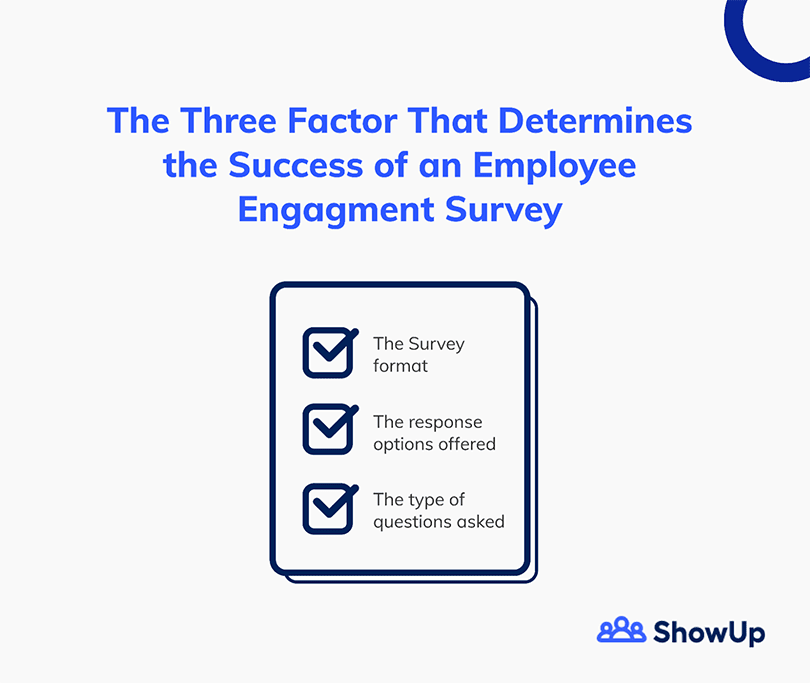
Let’s look at these three factors briefly:
The format of the survey should be a pulse-like format, i.e. short, specific, and frequent (weekly or bi-weekly).
For the response options offered, a 5 or in some cases, 7 point Likert scale has been found to work best. To clarify, a Likert scale is a response scale used to depict people’s opinions and feelings to a question.
This leaves us with the third factor:
The type of questions to be asked.
Paying close attention to the questions in your engagement survey goes a long way in determining the quality of feedback you receive.
Like Mitch Zenger, Founder, and future of work advocate said:
If we want to change what our employees care about, we must change what questions we regularly ask our employees.
In other words, asking the right questions in the right and timely way is the key to improving employee engagement. So what kind of questions should you be asking?
That’s precisely what I’ll show you in this article.
You’ll see how to design an employee pulse survey with an accredited employee engagement survey template. You’ll also learn more about the kind of questions you should include in your survey. And even better, I’ll show you how the entire surveying process can be made easier with one automated employee engagement pulse tool:
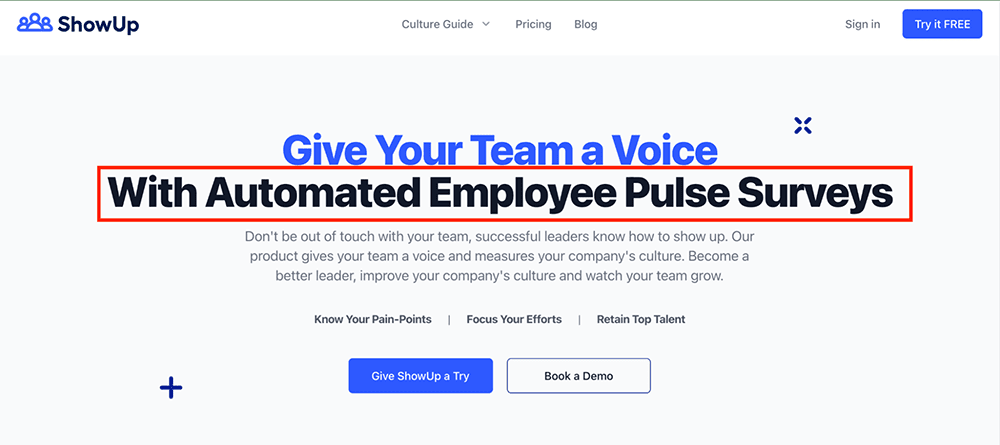
Automate your employee engagement survey process with ShowUp
Ready?
Let’s dive in.
Table of Contents:
What makes a good employee engagement survey question?
A good employee engagement survey question has the following characteristics:
- Anonymity
- Specificity
- Engaging, not boring
- Relevant, and not full of fluff
- Jargon and confusion-free
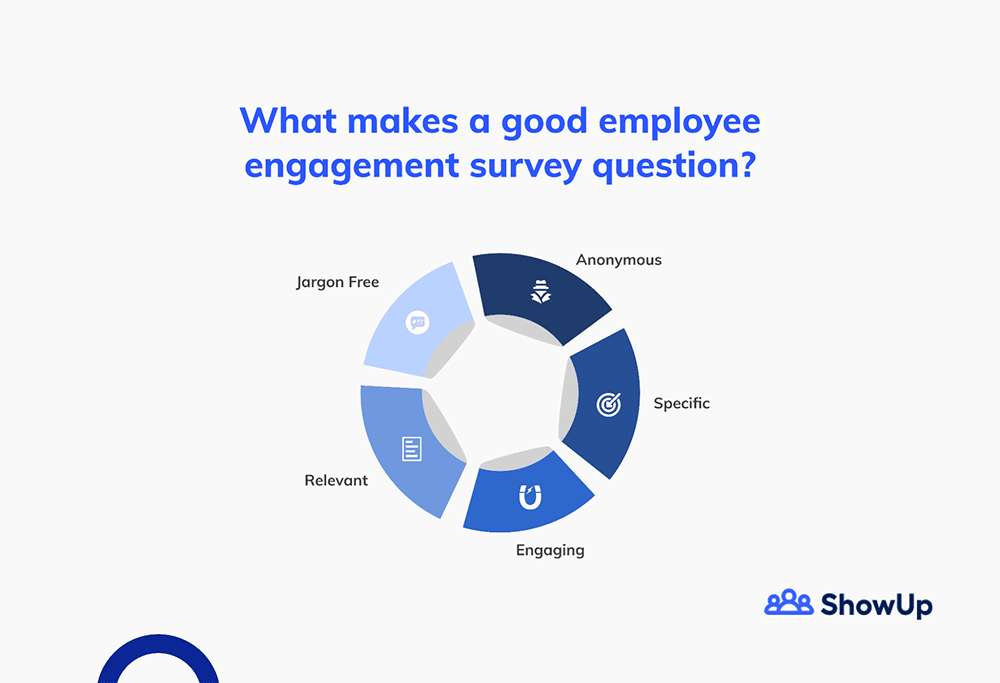
The characteristics listed above should give you an inkling of what your survey questions should be like. But for clarity, below is an employee engagement survey template.
This employee survey template follows ShowUp’s guidelines and is suitable for a manager with 10-15+ employees.
Build your own Employee Engagement Pulse Survey By Asking These Questions
Before I show you the employee engagement survey template, let me ask you this:
What are the drivers of engagement and culture in your company?
You see, it is important to know these drivers, as they influence the type of questions to be asked.
ShowUp, after much research, has identified 6 drivers (or metrics), and 30 sub-drivers/sub metrics of employee engagement in any company.
These drivers are:
- Trust
- Alignment
- Transparency
- Innovation
- Respect and
- Passion.
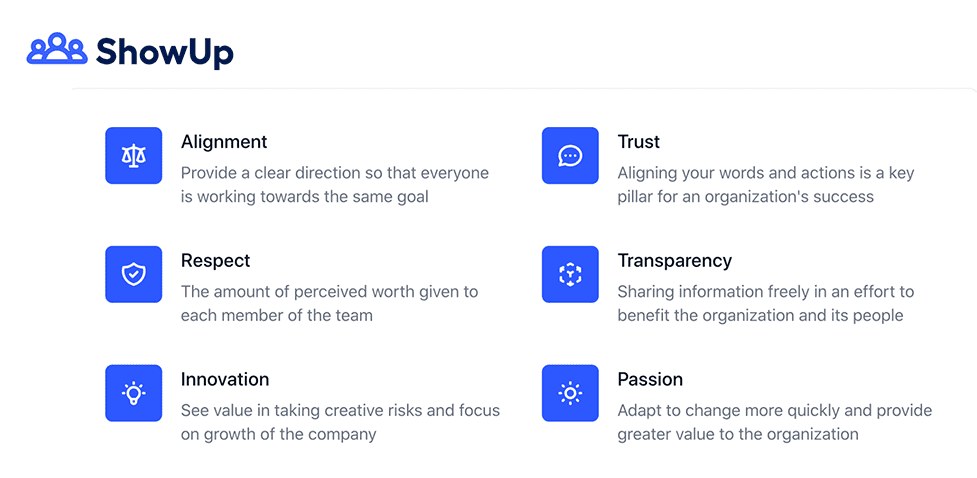
Your pulse engagement survey should contain a set of questions that target each of these metrics. Therefore, I’ll give more detail on each metric/driver and its accompanying questions.
Transparency
What exactly does it mean to be transparent with your team members?
Howard Schultz, former Chairman & CEO of Starbucks, gave an answer to this:
I think the currency of leadership is transparency. You've got to be truthful. I don't think you should be vulnerable every day, but there are moments where you've got to share your soul and conscience with people and show them who you are, and not be afraid of it.
Rephrased, you cannot be a great manager and leader if you’re not transparent with your employees. What is the implication of management-employee transparency?
Employee engagement.
I like the way Niraj Ranjan Rout, founder of Hiver linked employee engagement and transparency in this article:
Employee engagement without transparency is like a body without a soul. Without transparency, your employees will lack direction, let alone getting an emotional commitment.
Niraj’s words prove management transparency is a driver of employee engagement and commitment.
Therefore, your employee engagement survey should contain question(s) targeted at finding out what employees feel about the transparency level in the workplace.
Here are a few examples of transparency metric questions that you can implement in your pulse survey:
- My workplace actively seeks out new ways to improve communication and openness.
- I feel that leadership has my best interests in mind when making critical decisions.
- My workplace focuses on solutions to problems and not on placing blame.
More of these types of questions are found in ShowUp:
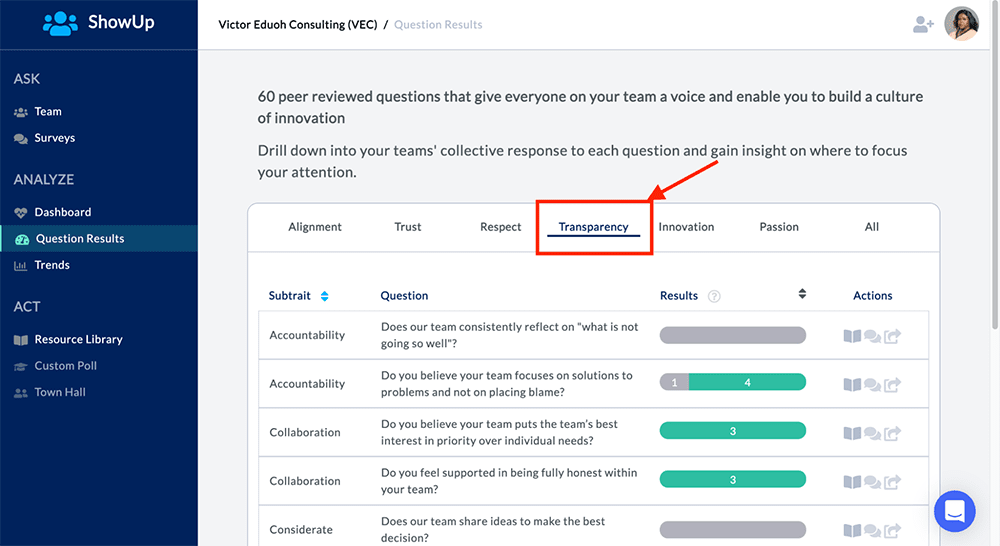
Trust
To show how trust in the workplace boosts engagement, Tim Sackett, HR Pro and President at HRU Technical Resources said:
The one true fact in all workplaces is your people want to be in the know, they want to be in the circle of trust. HR and leadership, in general, do a crappy job at this, and it has a huge impact on engagement. Find ways to make this happen and let your people know that it’s “inside” information. Trusting your employees can handle it raises engagement.
A 2017 SHRM employee job satisfaction and engagement report further revealed that 61% of employees feel trust between them (the employees) and their senior management is very important for their job satisfaction and engagement.
What does a pulse survey question that aims at measuring trust look like?
Check it out below:
- My team is being given what they need from the organization to deliver their work.
- I am able to communicate openly and honestly with my management team.
- I feel rewarded upon successful completion of a project.
Likewise, ShowUp has a lot more questions on Trust:
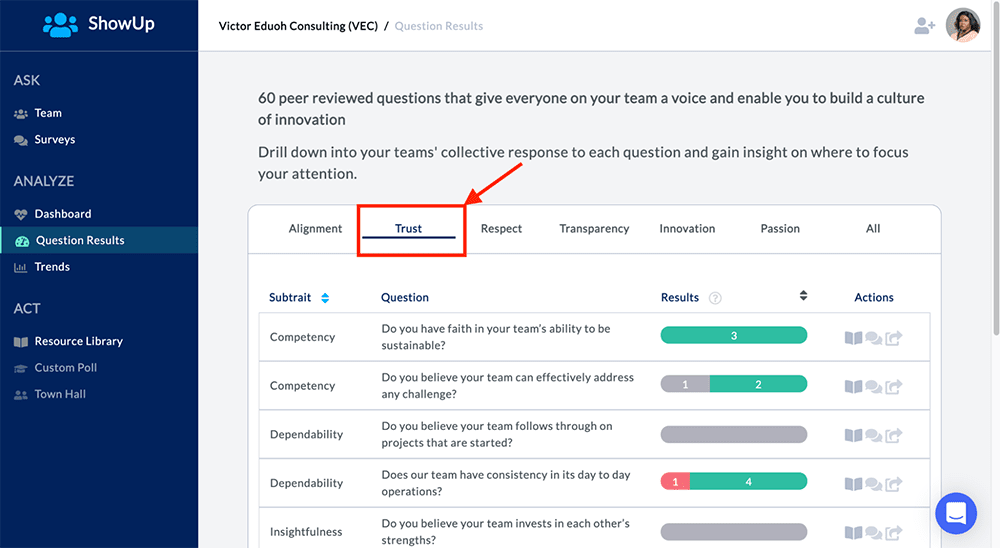
Respect
Another question(s) that should be included in your pulse surveys is:
- Leaders and employees hold themselves accountable for their mistakes.
- I feel recognized at work.
- I am given responsibility that's matched with my performance.
The above questions fall under certain sub metrics like courtesy, encouragement, and empathy respectively, but are classified under the metric ‘Respect’ in ShowUp:
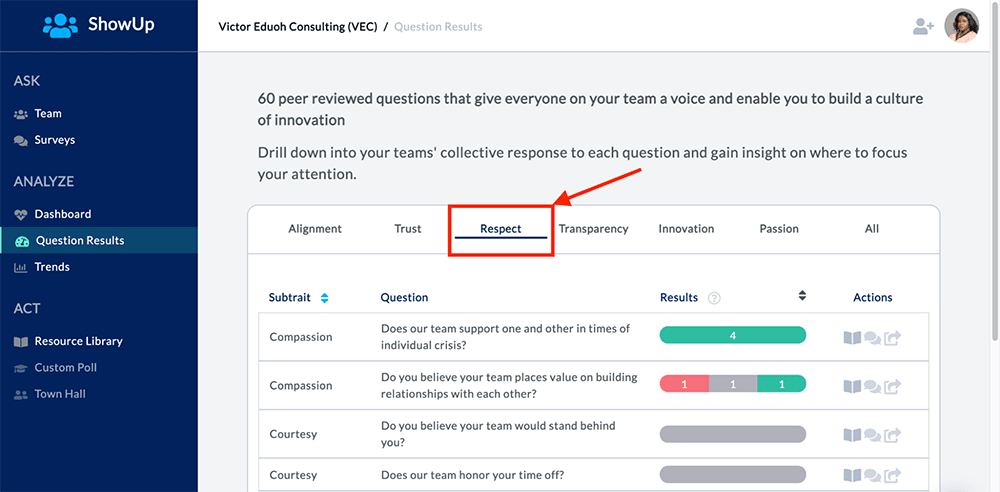
Asking respect-based questions in your pulse survey is very important because respect drives overall engagement.
Paul Marciano, organizational psychologist, and author hit the nail on the head when he wrote:
Respect is the lynchpin of employee engagement.
Darcy Jacobsen, in an article titled "The Secret to Respect in the Workplace” shared similar sentiments about respect:
It (Respect) also plays a key role in recognition, engagement, and in creating a strong organizational culture.
In fact, 65% of employees agree that management respect plays an important role in their job satisfaction and engagement in a recent study by SHRM.
You see why your employee engagement survey should include questions targeting respect, right?
Great. Let’s look at Passion, the fourth driver of employee engagement.
Passion
A study by Sylvia Diana Purba and Andhie Novien Dwi Ananta showed a significant and direct positive influence between work passion and work engagement.
Therefore, it is imperative for managers to constantly check if employees are still passionate about their jobs. You can do this by asking the following questions in your survey:
- I am able to test my knowledge and abilities in my day to day work
- My company provides access to learning of my choice that may include, book purchase program, classroom training, work time set aside for learning.
- Does our team give each other that extra push when needed to keep going?
More questions on passion can be found in ShowUp’s database, as evidenced below:
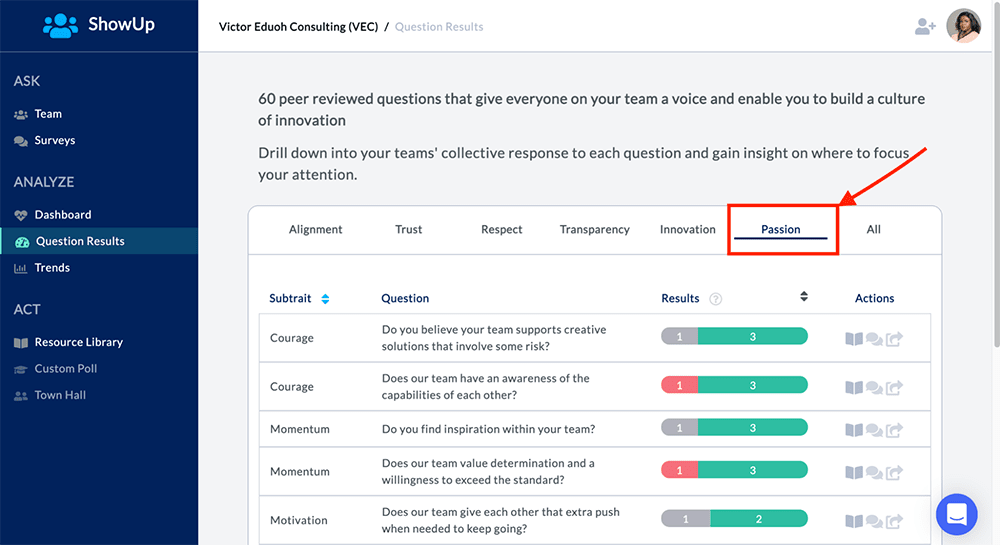
Alignment
As this ShowUp’s article stated, the core of team alignment is a shared purpose. Employees that are aligned with the company’s vision and values are more engaged than unaligned employees.
In fact, an achievers report shows that employees whose personal values are very well-aligned with their company’s values are five times more likely to report being engaged.
On values and alignment in the workplace, Brittany Forsyth’s words come to mind:
Determine what behaviors and beliefs you value as a company, and have everyone live true to them.
Don’t know what alignment questions to ask in your survey?
Check these out:
- My work responsibilities and expectations are clear and I know what is expected of me.
- I am really enthusiastic about the overall vision of the company.
- I feel that my teammates understand and appreciate my values.
ShowUp has more questions on alignment as seen below:
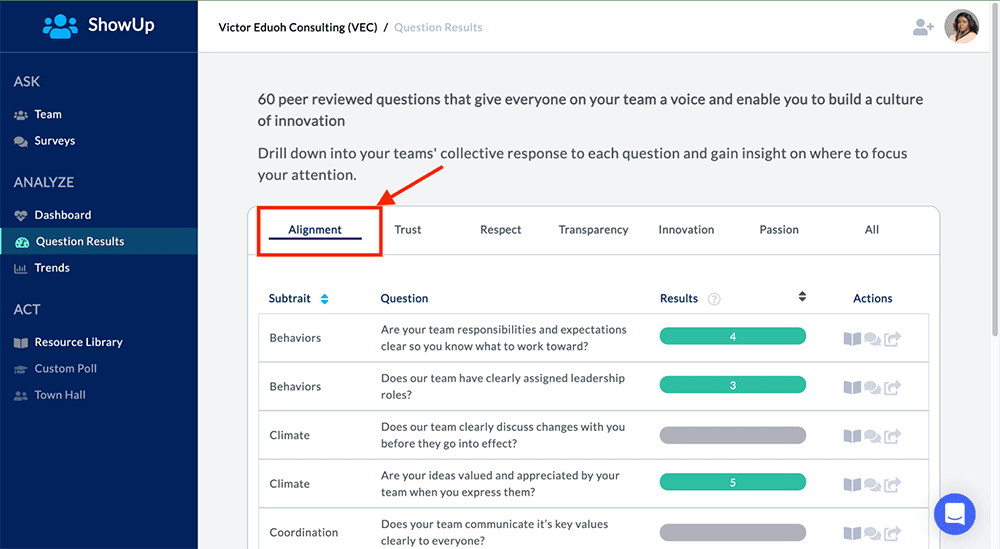
Innovation
Pulse survey questions that are targeted at fostering a culture of innovation in the workplace usually go like this:
- I am empowered by my company to take actions on my ideas.
- My company empowers me to strive for my best in the work I deliver.
- I feel safe presenting my ideas to my co-workers.
It is important for questions like the above to be included in your employee engagement survey. As this Culture amp’s data revealed, nearly 8 out of 10 highly engaged employees regard their companies as having a culture that nurtures innovation, whereas only half of the least engaged employees feel that.
Like to see more survey questions targeted at innovation, a driver of engagement? Check out a snippet from ShowUp:
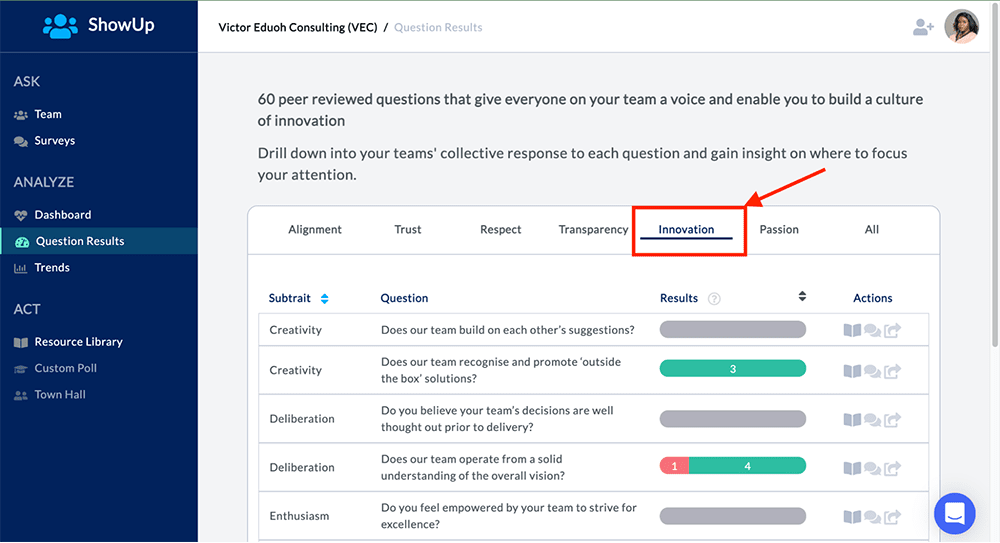
There you have it, a template for designing an effective employee engagement pulse survey.
After selecting a question or two from each driver or metric of engagement, your final survey result should look something like this:
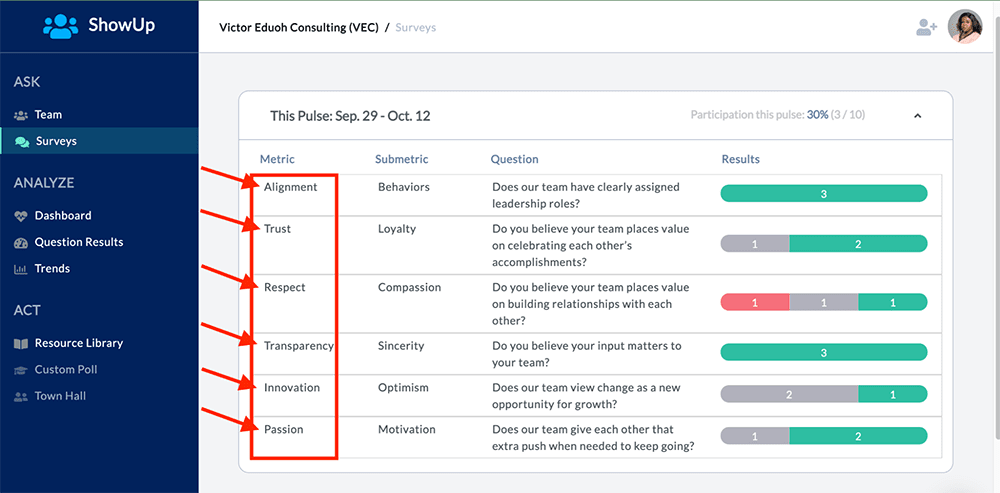
Now, your employee engagement survey questions are ready.
What next? How do you host and send out these surveys?
That’s what is covered in the next section of this article.
How to implement your employee engagement survey strategy.
Some managers host their surveys on tools such as survey monkey, Google Docs, etc. However, as observed in this SurveyMonkey employee engagement alternative article, these tools are not all that great for employee engagement purposes.
And this is due to reasons such as:
- Lack of anonymity of responses waters down the quality of the results.
- It is simply too much work for a busy manager to send out these surveys and individually analyze each response on a weekly/bi-weekly basis.
Therefore, a better way to implement your employee engagement survey strategy, and get genuine feedback is by using an employee engagement pulse tool like ShowUp.
Why?
For one, ShowUp automates the whole process, from sending out the surveys to crunching the whole data and helping you act.
Also, ShowUp’s responses are totally anonymous:
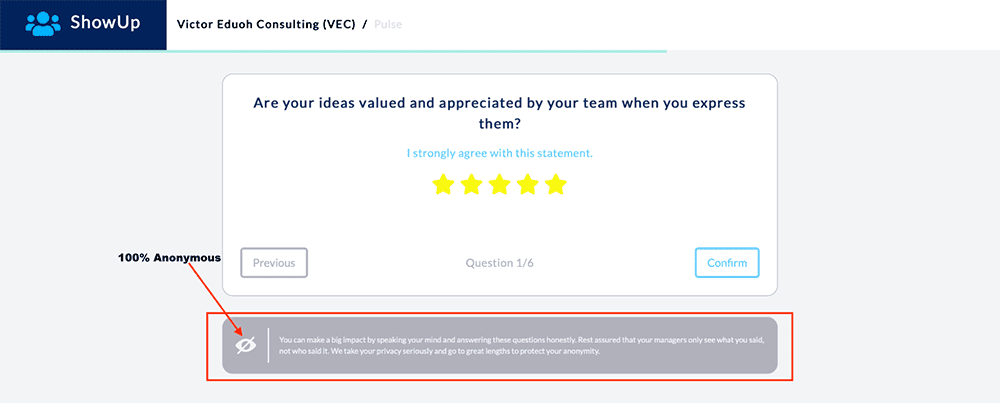
More about how ShowUp works is detailed below.
How ShowUp helps busy managers implement their employee engagement survey strategy
ShowUp has generated 60 peer-reviewed questions that are designed to improve employee engagement and workplace culture.
At regular intervals, i.e weekly or bi-weekly, ShowUp automatically sends out a pulse employee engagement survey containing 6 of these questions:
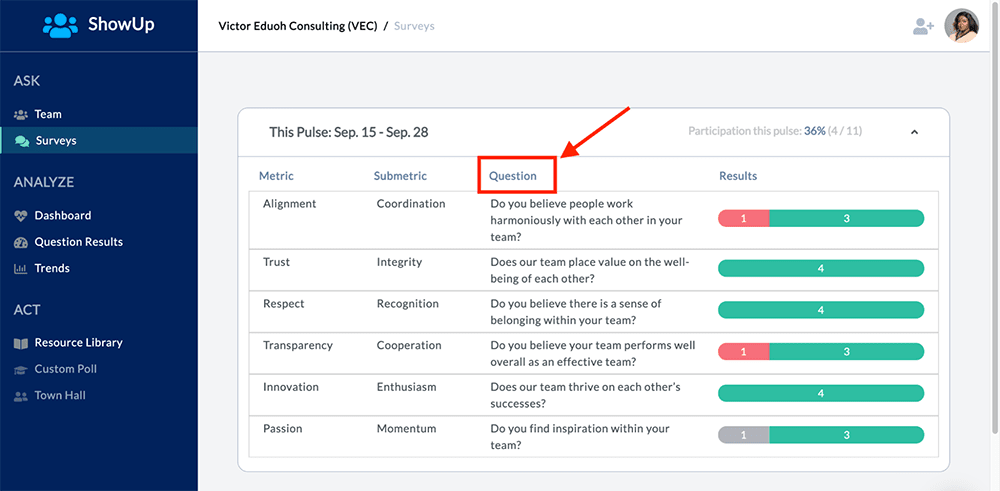
Then, to save you stress, the tool analyzes the result from the survey for you:
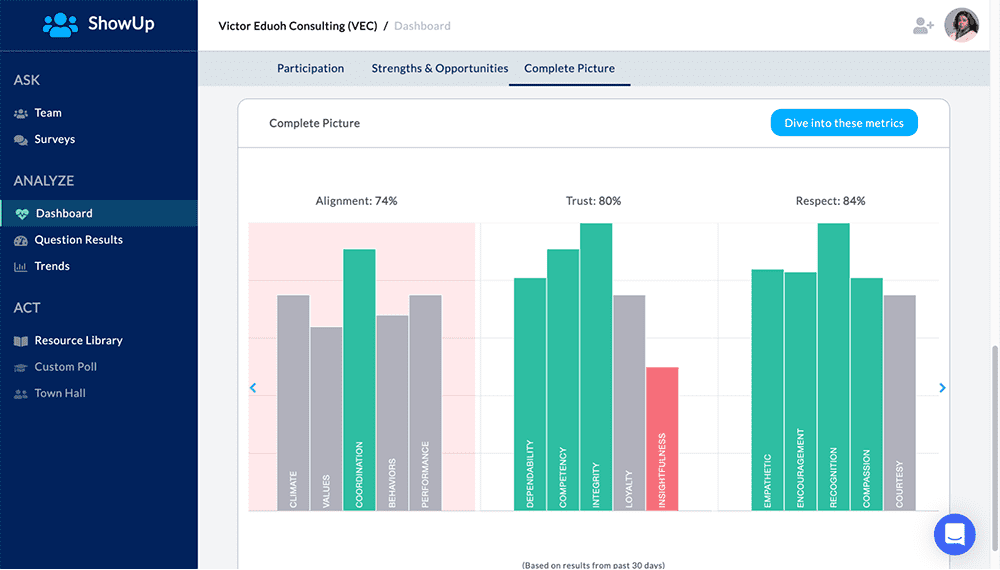
And finally, recommends an action plan:
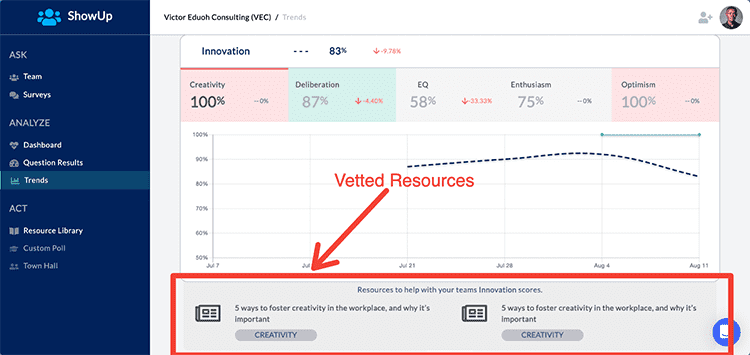
A tool like ShowUp is an easier and more effective way for managers to send out employee engagement surveys.
Send out more effective employee engagement surveys
Conclusion: Employee engagement surveying is a continuous process, not a one-off
Marshall Goldsmith, an executive leadership coach, once said:
Engaged employees will make you money, disengaged employees will cost you money.
As a manager, it is in your best interests, and good practice to strive to improve employee satisfaction and engagement.
And an excellent way to do this is by sending out pulse surveys continuously to measure employee engagement.
This singular action has contributed to the growth of several other companies and can do the same for you too.
ShowUp makes surveying employees less of a chore for managers like you.
